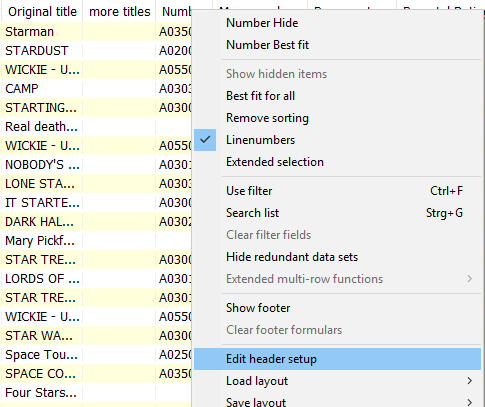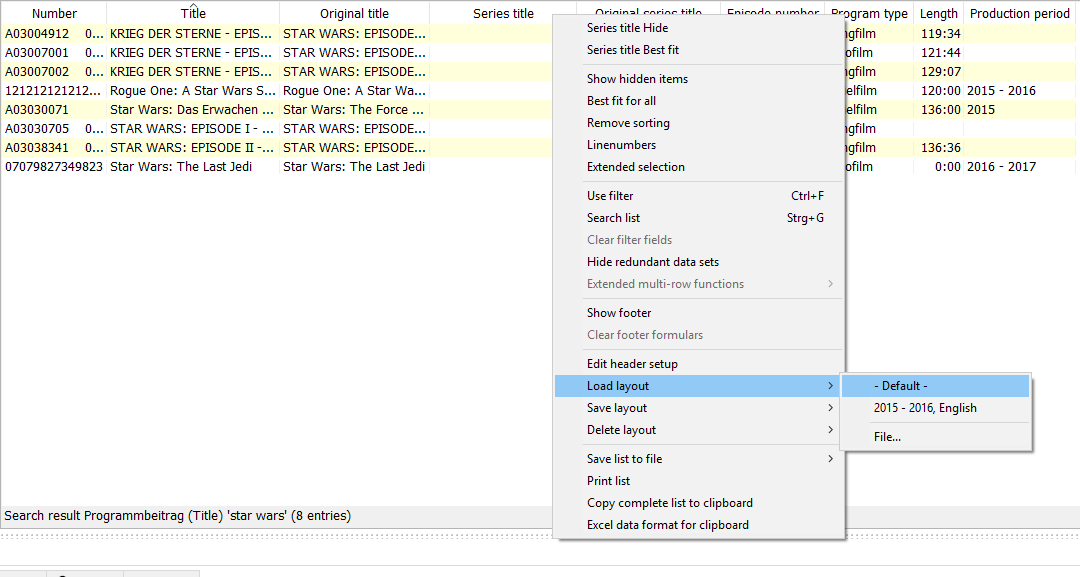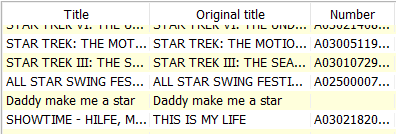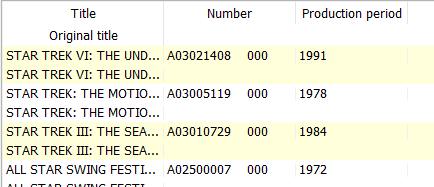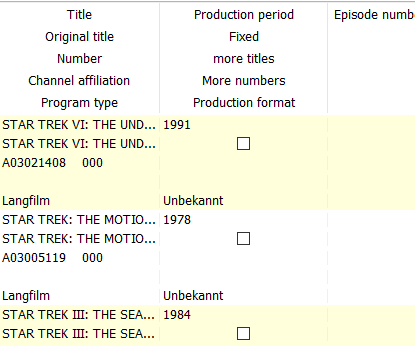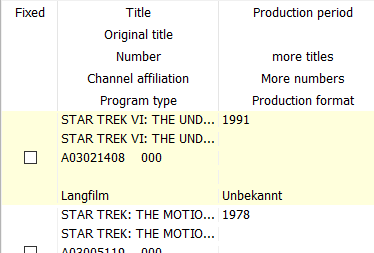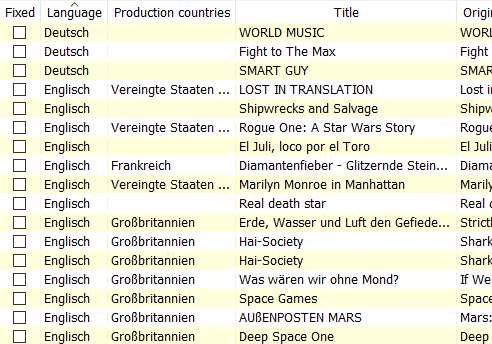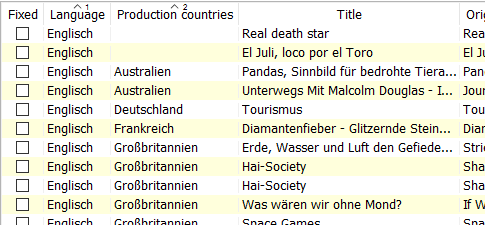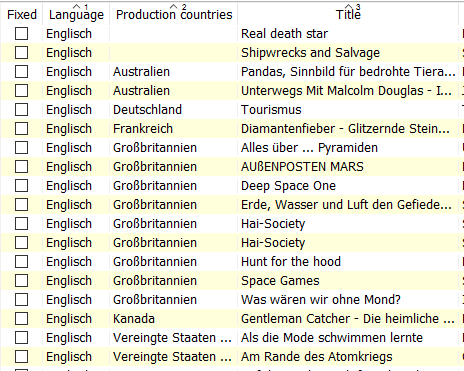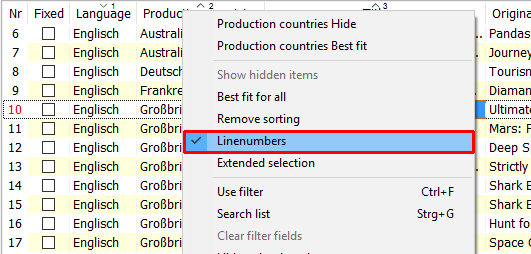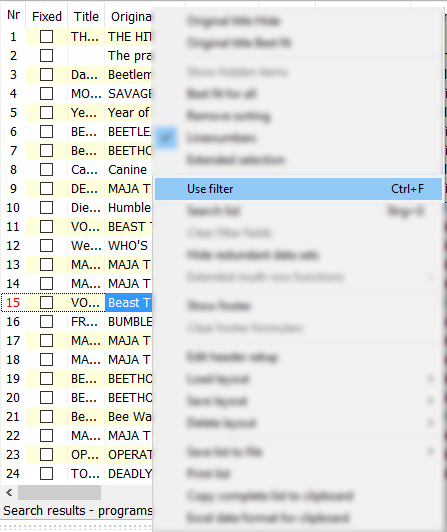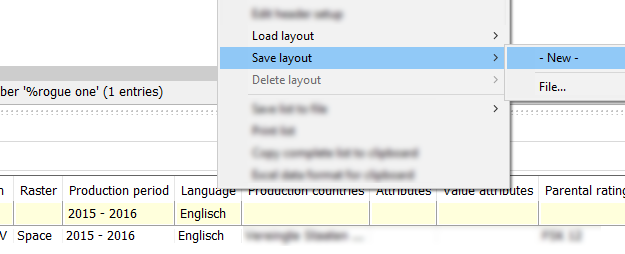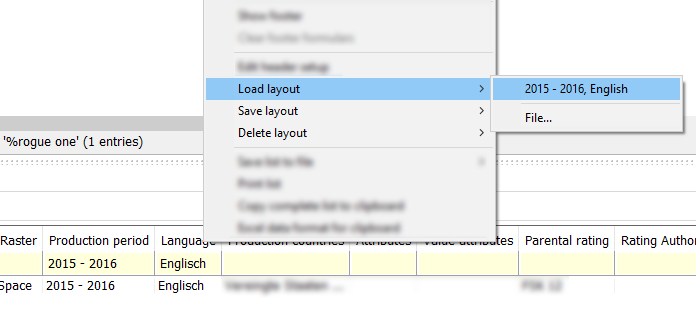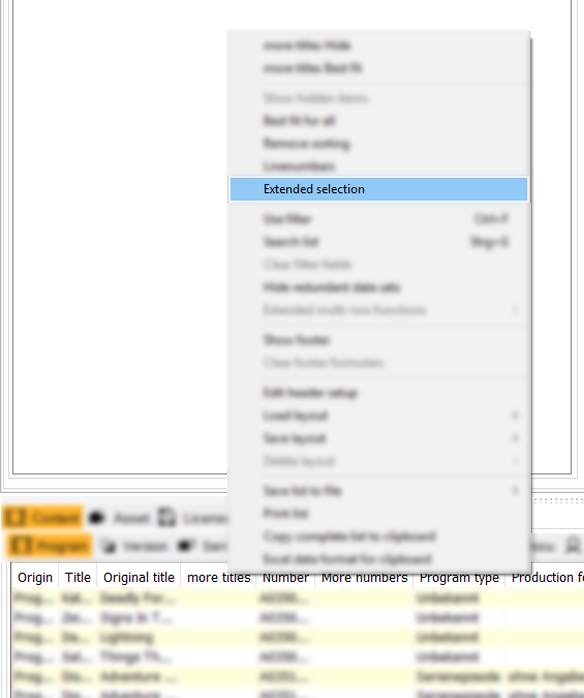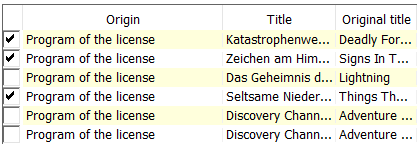1.1.4 Personal list layouts
Every user can design the layout of the lists in the results area and the details area himself. He can use different functions to design his lists and to ensure, that he sees all the information he needs.The settings are saved for every user individually and can be copied to other users.
Header Setup
Many settings can be found in the header setup. Some of then can be accessed by a shortcut.
To open the header setup, please proceed as follows:
- Right-click the header of the list.
- Select Edit header setup.
→ The dialog Settings for list header opens.
In this dialog, you can adjust the following things:
| Name | Function | Description | Shortcut |
|---|---|---|---|
| Set default | Setting the layout back to default | Sets the complete header setup to a simplified standard view, which only shows the most important columns. This can then be extended by the columns you need. | Right-click the header setup > Load Layout > - Default - |
| X position | Determining the horizontal position of a column | With this function, you can determine the order of the columns. For example, you can determine, that the title is the first column, then the original title and then the number. | You can determine the order of the columns per drag-and-drop. Just drag the column to another position. |
| Y position | Determining the vertical position of a column | With this function, you can position several columns above of each other: One column: Two columns: Five columns: | You can determine the vertical position of the columns per drag-and-drop. Just drag the column below another. |
| Width | Determining the width of a column | With this function, you can determine the width of a column. | You can determine the width of the columns per drag-and-drop. Just drag the edge of the column. |
| Height | Determining the height of a column | With this function, you can determine the height of a column. This is for multi-lined lists. In the following example, the column Fixed is 5 lines high, all other columns are just one line high. | You can determine the height of the columns per drag-and-drop. Just drag the lower or upper edge of the column. |
| Visible | Show/hide column | With this functions, you can hide or show columns. This helps you to reduce your layout to the interesting columns. | You can hide columns, by right-clicking them in the header. But hidden columns can only be made visible again in the header setup. |
| Text color | Determining the text color of the column | With this function, you can color your list. | |
| Text bold | Determining the appearance of the font (bold/normal) | With this function, you can make the columns bold. | |
| Sort order | Determining the order of the table | With this function, you can determine the order of the list. There is a primary order, a secondary, a tertiary and so on. In the column of the primary order, please write a 1. For the secondary order, please write a 2. The secondary order determines the order within the primary order. As soon as the secondary order is activated, small numbers are shown in the header. Example: Primary order by language Example: Secondary order by production countries Example: Tertiary order by title | The primary order can be activated by a simple click on the column header. If you then click on another column, this column will be the new primary order. If you want to activate a secondary order, please hold the [SHIFT] key while clicking another column. This activates little numbers in the header. |
| Direction of sorting | Determining the direction of sorting | With this function, you can determine, whether the order should be upwards or downwards. | If you want to change the direction of the order, you can click the column header again. This also applies for the secondary order, but you have to make sure to press the [SHIFT] key, while clicking the column again. |
Numbering
To activate or deactivate the numbering of columns, please right-click the header.
Filter
Using a Filter
In all results and details lists of the ContentExplorer, you can activate filters. The filter can either be activated in Start > Filter or when you right-click the column header and select Use filter.
If you activate the filter, a new line appears under the column header. Here you can add filter restrictions:
- Filter menu: Go to the column you want to filter and select an entry from the drop-down menu.
- Costum filter: Additionally, the results can be filtered with AND and OR operators.
When you are filtering a list you can use different operators to refine your search results. You can use the following operators:Operator Name Description Example Search Finds Does not find No operator Finds everything, which begins with the search term. Leading articles (the, a) are ignored.
Bla Black; Blast; Black List; Blade 2; The Black Swan Men in Black; The Curse of the Black Pearl; Desert Blast % Leading percent operator
Finds everything, which contains the search term.
%Bla Blau; Blast; Men in Black; The Curse of the Black Pearl Balance; Badlands; Born on Planet Earth % Included percent operator Finds everything, where the first part is the beginning and the last part anywhere after.
B%la Black; Blast; Balance; Badlands; Born on Planet Earth Men in Black; The Curse of the Black Pearl _ Spaceholder for individual characters
Finds everything, which ends with the first part, are followed by an arbitrary character and are then followed by the second part. The operator _ can replace any character.
B_la Bola; Balance Badlands; Born on Planet Earth; Black; Men in Black | Logical operator OR
Finds everything, which begins with the first or second part.
Bla|Blu Black; Blue; Black List; The Blue Max; The Black Swan; Blue City; Men in Black; Dark blue & Logical operator AND Finds everything, which contains the first and the second part. Bla&%Blu The Black Blur; The Blue Max (German: DerblaueMax) Black; Blurr; ! Logical operator NOT
Finds everything, which does not contain the search term.
Searching for %Bla, then filtering for !(%ck) Blade 2; Blast Force Black List; Black Moon; The Black Swan () Logical brackets Helps you to combine several operators. < Kleiner als Finds everything, which is smaller than the search term. Letters are sorted by the alphabet.
Notice:
You can use these operators with the terms today and now. The filter "<today" only shows dates from the past. The filter "=today" only shows today. The filter now is useful for fields, which contain specific times.
Searching for %Bla, then filtering for: <p Blade 2; Desert Blast; Men in Black Pitch Black; Twins in Black and White > Größer als Finds everything, which is bigger than the search term. Letters are sorted by the alphabet.
Notice:
You can use these operators with the terms today and now. The filter ">today" only shows dates from the future. The filter "=today" only shows today. The filter now is useful for fields, which contain specific times.
Searching for %Bla, then filtering for:: >p Pitch Black; Twins in Black and White Blade 2; Desert Blast; Men in Black Notice:
In earlier versions, these operators also applied to the search in the ContentExplorer. This is not the case anymore. Now, the index search applies.
Saving a Filter
If you want to use a filter several times, you can save a filter and load it again. In order to do this, please proceed as follows:
- Click right on a column header and select Use filter or press [CTRL + F].
- Adjust your filters and columns.
- Click right on a column header and select Save layout.
- Give the new layout a name and click OK.
→ The order of the columns and the filters are now saved and can be loaded anytime over Load layout.
If you do not need a layout anymore you can delete it with Delete Layout.
Extended Selection
The function Extended selection can be activated in any results list that allows for multiselection. A right-click on the title bar of the results list opens the menu in which you can activate extended selection.
Clicking on „Extended selection“ activates selection boxes that are displayed in the first column (next to the numbers). These boxes allow you to select multiple list entries; the selection is saved, i.e. it is preserved even if you click on one of the entry lines.
You can then choose a command via a context menu; this command will be applied to all selected entries. Please note that one of the selected entries has to be highlighted.
A menu that allows for selecting and deselecting all elements can be opened via right-click on the title line of the first column.
Notice:
Extended selection does not allow for drag-and-drop. Drag-and-drop is only possible if the desired entries are highlighted (press CTRL key and highlight individual lines).
